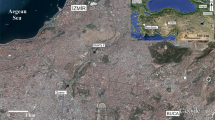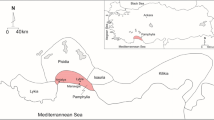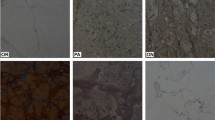Abstract
Four different rocks have been used in the architectural heritage of Morelia city (Michoacán state, México). Piedra Vieja (PV) is the original building rock whilst Tlalpujahua, Cointzio and Jabalina stones (TL, CO and JA, respectively) are the replacement varieties used in the restoration works during the last decades. All of them correspond to rhyolitic ignimbrites quarried close to Morelia. The new varieties were selected exclusively after aesthetical similarity, and no petrophysical criterion was considered. In this paper, a deep analysis of the weathering process of these rocks during wet–dry and salt crystallization cycles is carried out. Rock decay is defined in terms of linearity and homogeneity: JA and TL show nonlinear decay mode and heterogeneous behaviours, whilst samples of CO and PV weather after linear and homogeneous modes. Moreover, each rock variety shows different decay patterns, such as differential erosion (PV and TL), fractures (TL), scaling (JA) and granular disintegration (CO). All these obtained results are discussed according to: (1) petrographic factors; (2) hydric and mechanical properties; and (3) the partial effective pressures reached inside the porous system of each rock during salt crystallization. Finally, a review about the quality of previously published durability estimators is carried out. In general terms, results reveal that theoretical estimators best fit the visual weathering suffered by the rocks than its mass loss. Concluding this paper, a petrophysical and aesthetical evaluation of the compatibility between both original and replacement building stones used in the architectural heritage of Morelia is carried out in order to offer technical recommendations for future restoration works. CO ignimbrite offers the highest chromatic compatibility with the original building rock (PV), but its durability is extraordinarily low and consequently its use is not recommended. JA and TL are advisable replacement stones, although from a petrophysical point of view, TL results the most convenient. These results highlight the importance of carrying out the selection of building stones for restoration works according to petrophysical criteria, instead of using exclusively an aesthetic valuation.





Similar content being viewed by others
References
Alonso E, Martínez L (2003) The role of environmental sulfur on degradation of ignimbrites of the Cathedral in Morelia, Mexico. Build Environ 38:861–867
Andriani G, Walsh N (2003) Fabric, porosity and water permeability of calcarenites from Apulia (SE Italy) used as building and ornamental stone. Bull Eng Geol Environ 62(1):77–84
Angeli M, Bigas JP, Menéndez B, Hébert R, David C (2006) Influence of capillary properties and evaporation on salt weathering of sedimentary rocks. In: Fort R, Alvarez de Buergo M, Gomez-Heras M, Vezquez-Calvo C (eds) Heritage, weathering and conservation. Taylor & Francis/Balkema, Leiden, pp 253–259
Angeli M, Bigas JP, Benavente D, Menéndez B, Hébert R, David C (2007) Salt crystallization in pores: quantification and estimation of damage. Environ Geol 52:205–213
Benavente D, García-del-Cura MA, Fort R, Ordóñez S (2004) Durability estimation of porous building stones from pore structure and strength. Eng Geol 74:113–127
Cardenes V, Mateos FJ, Fernández-Lorenzo S (2014) Analysis of the correlations between freeze–thaw and salt crystallization tests. Environ Earth Sci 71:1123–1134
Chen TC, Yeung MR, Mori N (2004) Effect of water saturation on deterioration of welded tuff due to freeze–thaw action. Cold Reg Sci Technol 38:127–136
Cisneros-Máximo G (2015) Estudio geológico-geomorfológico de los volcanes Tetillas-Quinceo. Propuesta de cartografía Jerárquica. Maestría en geografía. Facultad de Filosofía y Letras; Universidad Nacional autónoma de México, Morelia, Michoacán
Columbu S, Gioncada A, Lezzerini M, Marchi M (2014) Hydric dilatation of ignimbritic stones used in the church of Santa Maria di Otti (Oschiri, northern Sardinia, Italy). Ital J Geosci 133(1):149–160
Corona-Chávez P, Mennella L, Salgado-Soto Z, Garduño-Monroy VH (2000) Carta geológico-minera de la hoja Angangueo, escala 1: 50000, con notas explicativas. Consejo de Recursos Minerales-Secofi, México
De la Teja G (2000) Carta geológico-minera de la hoja El Oro, escala 1: 50000, con notas explicativas. Consejo de Recursos Minerales-Secofi, México
Di Benedetto C, Cappelletti P, Favaro M, Graziano SF, Langella A, Calcaterra D, Colella A (2015) Porosity as key factor in the durability of two historical building stones: neapolitan Yellow Tuff and Vicenza Stone. Eng Geol 193:310–319
Ferrari L, Garduño VH, Pasquaré G, Tibaldi A (1994) Volcanic and tectonic evolution of central México: oligocene to present. Geofis Int 33(1):91–105
Garduño-Monroy VH, Arreygue-Rocha E, Israde-Alcántara I, Rodríguez-Torres G (2001) Efectos de las fallas asociadas a sobreexplotación de acuíferos y la presencia de fallas potencialmente sísmicas en Morelia, Michoacán, México. Revista Mexicana de Ciencias Geológicas 18(1):37–54
Gómez-Vasconcelos MG, Garduño-Monroy VH, Macías JL, Layer PW, Benowitz JA (2015) The Sierra de Mil Cumbres, Michoacán, México: transitional volcanism between the Sierra Madre Occidental and the Trans-Mexican Volcanic Belt. J Volcanol Geotherm Res 301:128–147
Graue B, Siegesmund S, Middendorf B (2011) Quality assessment of replacement stones for the Cologne Cathedral: mineralogical and petrophysical requirements. Environ Earth Sci 63:1799–1822
Griffith AA (1924) Theory of rupture. In: Proceedings of 1st international congress of applied mechanics. Delft, pp 55–63
Julia F, Vladimir L, Sergey R, David Z (2014) Effects of hydrothermal alterations on physical and mechanical properties of rocks in the Kuril–Kamchatka Island Arc. Eng Geol 183:80–95
Korkanç M (2013) Deterioration of different stones used in historical buildings within Nigde province, Cappadocia. Constr Build Mater 48:789–803
La Iglesia A, González V, López-Acevedo V, Viedma C (1997) Salt crystallization in porous construction materials I. Estimation of crystallization pressure. J Cryst Growth 177(1–2):111–118
La Russa MF, Ruffolo SA, Rovella N, Belfiore CM, Pogliani P, Pelosi C, Andaloro M, Crisci GM (2014) Cappadocian ignimbrite cave churches: stone degradation and conservation strategies. Periodico di Mineralogia 83(2):187–206
Leventis A, Verganelakis DA, Halse MR, Webber JB, Strange JH (2000) Capillary imbibition and pore characterization in cement pastes. Transp Porous Media 39:143–157
López-Doncel R, Wedekind W, Dohrmann R, Siegesmund S (2013) Moisture expansion associated to secondary porosity: an example of the Loseros Tuff of Guanajuato, Mexico. Envorin Earth Sci 69:1189–1201
López-Doncel R, Wedekind W, Leiser T, Molina-Maldonado S, Velasco-Sánchez A, Dohrmann R, Kral A, Wittenborn A, Aguillón-Robles A, Siegesmund S (2016) Salt bursting tests on volcanic tuff rocks from Mexico. Environ Earth Sci 69:1189–1201
López-Moreno A, Sepúlveda-Sánchez JD, Alonso Guzmán EM, Le Borgne S (2014) Calcium carbonate precipitation by heterotrophic bacteria isolated from biofilms forme don deteriorated ignimbrite Stones: influence of calcium on EPS production and biofilm formation by these isolates. Biofouling 30(5):547–560
Madsen FT, Müller-Vonmoos M (1989) The swelling behaviour of clays. Appl Clay Sci 4:143–156
Martínez-Martínez J, Benavente D, García-del-Cura MA (2011) Spatial attenuation: the most sensitive ultrasonic parameter for detecting petrographic features and decay processes in carbonate rocks. Eng Geol 119:84–95
Martínez-Martínez J, Benavente D, Gómez-Heras M, Marco-Castaño L, García-del-Cura MA (2013) Non-linear decay of building stones turing freeze–thaw weathering processes. Constr Build Mater 38:443–454
Mod’d BK, Howarth RJ, Bland CH (1996) Rapid prediction of building research establishment limestone durability class from porosity and saturation. Q J Eng Geol 29:285–297
Morales-Gámez M, Corona-Chávez P (2006) Geotecnia y problemática de extracción en los bancos de rocas ornamentales de la región de Tlalpujahua. Revista de Investigación de la Universidad Michoacana de San Nicolás de Hidalgo. 43:113–130
Ordóñez S, Fort R, García del Cura MA (1997) Pore size distribution and the durability of a porous limestone. Q J Eng Geol 30:221–230
Ostrooumov M (2009) A Raman IR and XRD análisis of the deterioration on historical monuments: case study from Mexico. Spectrochimica Acta Part A 73:498–504
Ostroumov M, Garduño-Monroy VH, Carreón-Nieto H, Lozano-Santa Cruz R (2003) Mineralogía y geoquímica de los procesos de degradación en monumentos históricos: primer acercamiento a un caso mexicano (Morelia, Michoacán). Revista Mexicana de Ciencias Geológicas 20(3):223–232
Özbek A (2014) Investigation of the effect of wetting–drying and freezing–thawing cycles on some physical and mechanical properties of selected ignimbrites. Bull Eng Geol Environ 73:595–609
Özvan A, Dinçer I, Akin M, Oyan V, Tapan M (2015) Experimental studies on ignimbrite and the effect of lichens and capillarity on the deterioration of Seljuk Gravestones. Eng Geol 185:81–95
Penide J, Quintero F, Riveiro A, Sánchez-Castillo A, Comesaña R, del Val J, Lusquiños F, Pou J (2013) Removal of graffiti from quarry stone by high power Diode laser. Opt Lasers Eng 51:364–370
Pereira D, Marker B (2016) The value of original natural stone in the context of architectural heritage. Geosciences 6:1–9
Pradal E, Robin C (1994) Long-lived magmatic phases at Los Azufres volcanic center, Mexico. J Volcanol Geotherm Res 63:201–215
Richardson BA (1991) The durability of porous stones. Stone Ind 26(10):22–25
Rodriguez-Navarro C, Dohene E (1999) Salt weathering: influence of evaporite rate, supersaturation and crystallisation pattern. Earth Surf Proc Land 23(3):191–209
Rozenbaum O, Barbanson L, Muller F, Bruand A (2008) Significance of a combined approach for replacement stones in the heritage buildings’ conservation frame. C.R. Geoscience 340:345–355
Smith BJ, Gomez-Heras M, McCabe S (2008) Understanding the decay of stone-built cultural heritage. Prog Phys Geog 32(4):439–461
Smith BJ, Gomez-Heras M, Viles HA (2010) Underlying issues on the selection, use and conservation of building limestone. London: geological Society. Spec Publ 331:1–11
Topal T, Doyuran V (1998) Analyses of deterioration of the Cappadocian tuff, Turkey. Environ Geol 34:5–20
Topal T, Sözmen B (2003) Deterioration mechanisms of tuffs in Midas monument. Eng Geol 68:201–223
Ulusoy M (2007) Different igneous masonry blocks and salt crystal weathering rates in the architecture of historical city of Konya. Build Environ 42:3014–3024
UNE-EN 12370 (1999) Natural stone test methods. Determination of resistance to salt crystallisation. European Committee for Standarization, Madrid
UNE-EN 1925 (1999) Natural stone test method. Determination of water absorption coefficient by capillarity. European Committee for Standarization, Madrid
UNE-EN 1926 (2007) Natural stone test methods. Determination of uniaxial compressive strength. European Committee for Standarization, Madrid
UNE-EN (1936) Natural stone test method. Determination of real density and apparent density and of total and open porosity. European Committee for Standarization, Madrid
Urosevic M, Sebastián E, Cardell C (2013) An experimental study on the influence of surface finishing on the weathering of a building low-porous limestone in coastal environments. Eng Geol 154:131–141
Vergès-Belmin V (2010) Deterioration of stone in monuments. In: Schrefler B, Delage P (eds) Environmental geomechanics. ISTE Ltd, London
Wedekind W, López-Doncel R, Dohrmann R, Kocher M, Siegesmund S (2013) Weathering of volcanic tuff rocks caused by moisture expansion. Environ Earth Sci 69:1203–1224
Wellman HW, Wilson AT (1965) Salt weathering, a neglected geological erosive agent in coastal and arid environments. Nature 205:1097–1098
Yavuz AB (2012) Durability assessment of the Alacti tuff (Izmir) in western Turkey. Environ Earth Sci 67:1909–1925
Yavuz AB, Akal C, Türk N, Çolak M, Tanyu BF (2015) Investigation of discrepancy between tuff used as building stones in historical and modern buildings in western Turkey. Constr Build Mater 93:439–448
Yu S, Oguchi CT (2010) Role of pore size distribution in salt uptake, damage, and predicting salt susceptibility of eight types of Japanese building stones. Eng Geol 115:226–236
Zedef V, Kocak K, Doyen A, Ozsen H, Kekec B (2007) Effect of salt crystallization on stones of historical building and monuments, Konya, Central Turkey. Build Environ 42:1453–1457
Author information
Authors and Affiliations
Corresponding author
Additional information
This article is part of a Topical Collection in Environmental Earth Sciences on “Stone in the Architectural Heritage: from quarry to monuments – environment, exploitation, properties and durability”, guest edited by Siegfried Siegesmund, Luís Sousa, and Rubén Alfonso López-Doncel.
Rights and permissions
About this article
Cite this article
Martínez-Martínez, J., Pola, A., García-Sánchez, L. et al. Building stones used in the architectural heritage of Morelia (México): quarries location, rock durability and stone compatibility in the monument. Environ Earth Sci 77, 167 (2018). https://doi.org/10.1007/s12665-018-7340-7
Received:
Accepted:
Published:
DOI: https://doi.org/10.1007/s12665-018-7340-7




